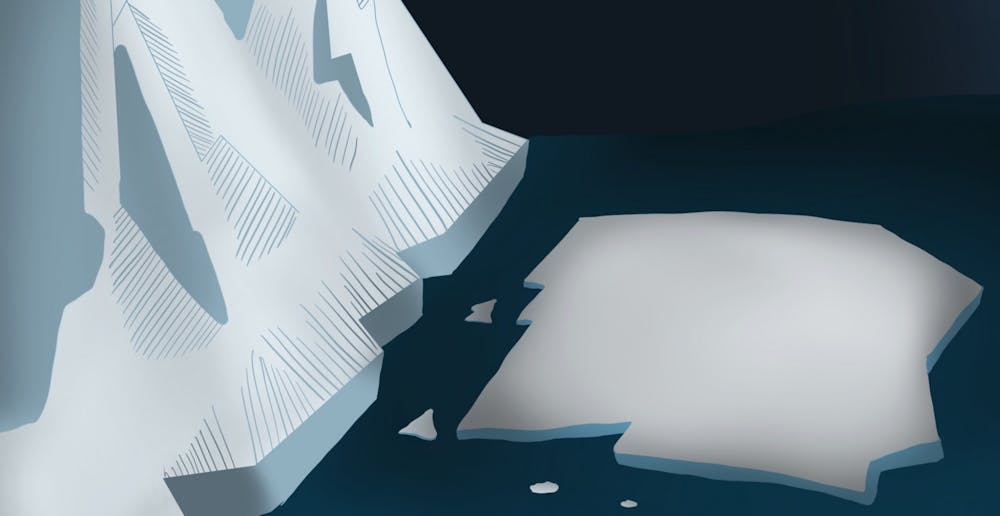Two years of research led by University researchers into sediment samples obtained from the Thwaites Glacier in Antarctica — also referred to as the “Doomsday Glacier” — came to its conclusion earlier this month with the publishing of an article by Nature Geoscience. This study revealed that the Thwaites Glacier has retreated twice as rapidly as expected. With similar retreat events feasible to occur again, our coastlines are directly impacted by the fate of this glacier.
While conducting this research, the University collaborated with other American colleges as well as international organizations, all working under the Thwaites Offshore Research project within the International Thwaites Glacier Collaboration. The project obtained its data through a series of three trips to the glacier between 2020 and 2022, with the first voyage embarking in January 2020.
On this initial voyage were graduate Arts & Sciences student Allison Lepp and graduate Arts & Sciences student Santiago Munevar Garcia, who spent two months on the research vessel studying the seafloor surrounding the glacier and collecting samples to send to laboratories for analysis. Lepp is a doctoral candidate studying Thwaites Glacier meltwater and Garcia is a doctoral candidate studying ice stream sensitivity in subglacial topography.
“Working on an Antarctic research expedition was an incredible experience,” Lepp said in an email to The Cavalier Daily. “It's a fast-paced environment where science is ongoing every hour of the day in order to maximize the time. The diverse researchers present … promoted a collaborative and interdisciplinary learning environment, much like the Department of Environmental Sciences at U.Va.”
While the Antarctic data collection was a vital step in determining the fate of the Thwaites Glacier, the largest conclusions could only be drawn after extensive analysis was conducted into close to 100 sediment cores brought back to the University from the research vessel.
These cores were analyzed in labs belonging to the University and other organizations associated with the THOR project. Researchers studied physical and chemical properties to determine the history of both the sediments and the glacier itself.
“With the sediment cores, each university got different samples and is doing something different with them,” Garcia said. “So at U.Va., Allison is the one working with sediments and she's taking a more chemical approach of the sediments with pore water analyses. And then other universities — like Alabama — are in charge of carbon dating to get an estimate of the ages of the sediment … So there's lots of different methods that each group is using.”
The data collected from this analysis was then used to connect trends between the retreating events of other Antarctic glaciers and the signs observed in the Thwaites in order to determine the causes behind its retreat. In a 2022 paper led by Lepp, the sediment cores were used to determine that signs of subglacial meltwater drainage in other glaciers was consistent with the retreating in the Thwaites Glacier, suggesting this drainage is a factor behind its melting.
While the melting of any glaciers can impact the environment, the Thwaites Glacier’s retreating event is particularly significant. With the single glacier contributing to 4 percent of global sea level rise, this particular glacier poses a greater risk to the coastlines than other individual glaciers in its surrounding area.
“The Thwaites Glacier is of high scientific priority and concern because of its rapid rate of change in recent decades,” Lepp said. “The likelihood that future retreat can be expected, and the sea-level rise that would be associated with future retreat. The Graham et al. (2022) paper demonstrates that Thwaites has retreated twice as rapidly as we have observed today in the past 200 years, and implies similar rapid retreat events are feasible in the future.”
The impacts of the Thwaites Glacier’s retreating event are not only felt in the Antarctic. The rise in sea level will affect both coasts of the United States, with the Northern Hemisphere in particular experiencing higher sea levels along its coasts. This effect, which poses a direct threat to Virginia coastlines and other areas of the Eastern Seaboard, is expanded upon by Lauren Simkins, assistant professor of environmental sciences and co-author of the Nature Geoscience paper.
“Because adding water to the oceans is not like adding water to a bathtub, actual sea levels in any particular location can deviate from global mean sea level,” Simkins said in an email to The Cavalier Daily. “Adding water to the oceans from Thwaites Glacier and the larger West Antarctic Ice Sheet will result in higher sea levels along the U.S. East and West coasts, and generally relatively higher in the Northern Hemisphere than the Southern Hemisphere.”
This is especially prevalent in Virginia, as Hampton Roads is the second largest population center at risk from sea level rise in the country. Worsened by the issue of sinking land, the sea level in parts of this area is rising by as much as one inch every four years. As the Thwaites Glacier melts, this problem will worsen at an alarming rate.
While the results of this research on the Thwaites Glacier are daunting, instead of viewing this retreating glacier as an inevitable disaster waiting to happen, Simkins chooses to focus on the ways that these projections can be improved.
“I believe the scientific community needs to better communicate their findings and the importance of seemingly far-off places and problems to broader audiences,” Simkins said. “However, this isn't something that we are explicitly trained to do but should feel a responsibility to do so.”
Simkins hopes that future research questions will be solved in more resourceful ways by using datasets that have already been collected and working across disciplinary lines in order to achieve more than what individuals believe to be possible.







